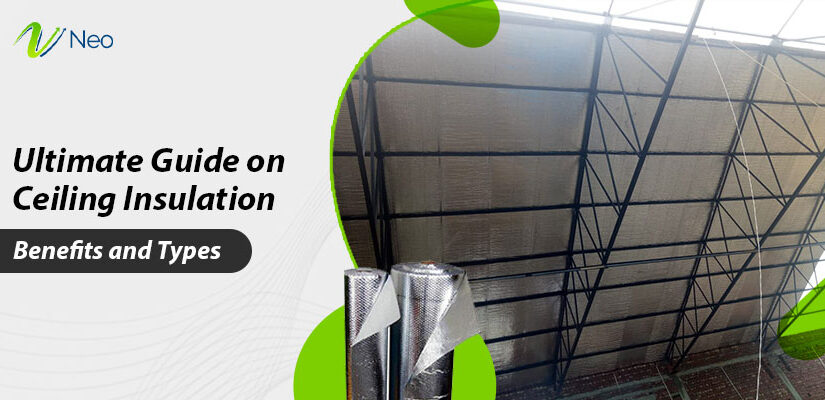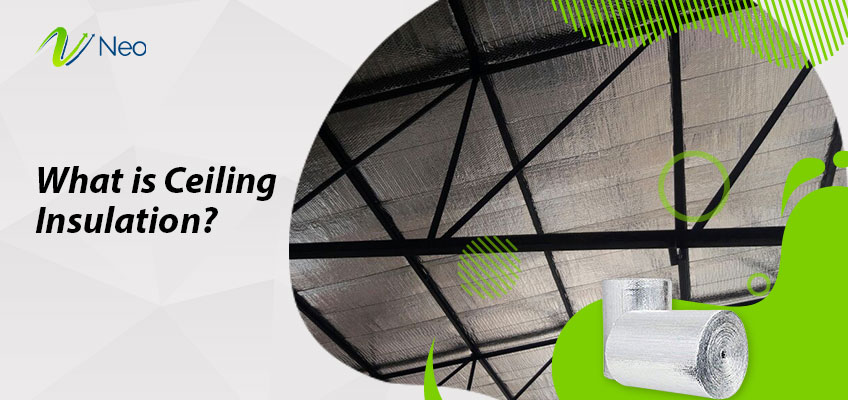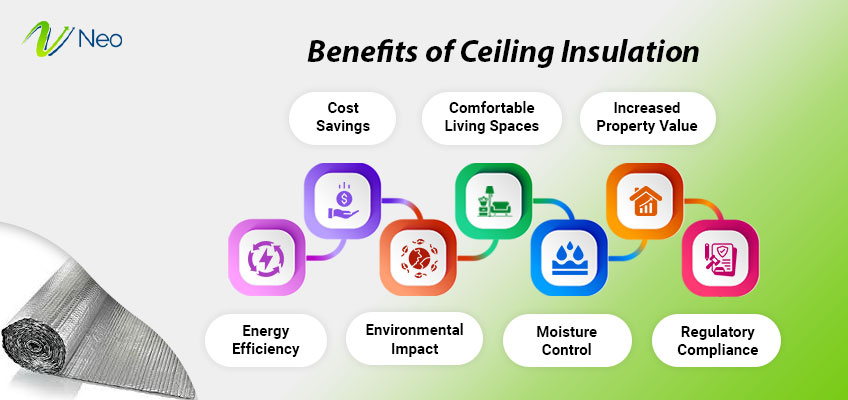Are you looking to adopt ceiling insulation in your house? The importance of ceiling insulation in creating a comfortable and energy-efficient household climate cannot be overemphasized. This thorough guide will cover various kinds of insulation materials and focus on the remarkable advantages that these materials hold.
This is where we shall unearth the benefits of an insulated ceiling for controlling year-round temperature as well as reducing energy consumption and bills. This guide is intended to provide information on the importance of ceiling insulation sheet for a homeowner, contractors, or anyone who wishes to make their house comfortable and safe.
In this blog, we will explore the benefits and types of ceiling insulation.
What is Ceiling Insulation?
Ceiling insulation is a name for a material or layer introduced between ceilings and rooftops of buildings to manage temperatures and provide energy efficiencies. This is meant to inhibit escaping warm air in winter and incoming hot air during summer.
There are several types of common insulation materials including fiberglass, cellulose, foam boards, and reflective foils. Ceiling insulation materials help maintain indoor comfort and decrease the demands of continuous heating/cooling and power savings. This helps to cut down costs as well as preserves environmental sustainability.
In addition, a ceiling insulation board is another effective method for improving total Building Thermal Insulation performance yielding an efficient and comfortable living or work space.
Read Also: Bubble Insulation Sheet(Types & Benefits)
Why Ceiling Insulation is Important?
For this reason, ceiling insulation is vital in many ways. First, it increases energy savings by serving as a thermal insulator reducing heat transfers in winter and retarding unwanted heat flows during summer. The air space between these layers acts as an insulator that helps maintain constant temperatures in the house, thus reducing the time and money usually spent on heating and cooling.
In addition, suitable ceiling heat insulation improves the general feeling of a premise. It helps in controlling temperature spikes and thereby increases a comfortable living space thus increasing productivity and health. Furthermore, when combined with other insulating materials, it helps reduce noise pollution from outside and improves sound acoustics within the space.
Get Year-Round Comfort In Your Home With Ceiling Insulation!
Besides this, ceiling insulation is essential to a sustainable environment. It reduces greenhouse gases that are linked with power generation by lowering power demand. This aligns with the worldwide policies for reducing carbon emissions and ecological construction and running of buildings.
Energy efficiency, comfortable living, soundproofing, and eco-friendliness; all depend on ceiling insulation. Its installation is a cheap investment that has long-term gains and therefore an essential aspect of modern-day construction activities.
What are the Types of Ceiling Insulation Sheets?
Ceiling thermal insulation is crucial for regulating temperature and enhancing energy efficiency within buildings. Various types of insulation materials and methods are employed to achieve effective thermal barriers in ceilings. Here are three common types:
1. Spray Foam Ceiling Insulation
Spray foam insulation is a popular choice for ceiling heat insulation foam due to its excellent thermal performance and versatility. It is applied as a liquid that expands into a foam, creating a seamless and airtight barrier. Spray foam adheres to the contours of the ceiling, filling gaps and voids that might be challenging for other insulation materials.
This type of insulation provides high R-values (a measure of thermal resistance) and effectively seals air leaks, contributing to improved energy efficiency. It is particularly beneficial in irregularly shaped ceilings or areas with obstacles, offering a uniform and efficient insulation solution.
2. Loose Fill Ceiling Insulation
Loose fill insulation, commonly made from materials like fibreglass or cellulose, is applied by blowing or pouring loose particles into the ceiling cavity. This method is well-suited for attics and spaces with irregular shapes or obstacles. The loose fill conforms to the contours of the ceiling, filling voids and creating a uniform layer of insulation.
It is effective in preventing heat transfer and offers good thermal resistance. Loose-fill insulation is known for its ability to cover hard-to-reach areas and provides an economical solution for ceiling insulation. It is essential to ensure even distribution to achieve optimal performance.
3. Blanket Ceiling Insulation
Blanket insulation, also known as batts or rolls, consists of pre-cut panels of fibreglass, mineral wool, or other materials. These panels are designed to fit standard ceiling joist spacings and are laid out like blankets across the ceiling. The installation process is relatively straightforward, making it a popular choice for both DIY projects and professional installations.
Blanket insulation provides an effective thermal barrier, reducing heat flow through the ceiling. It also offers sound absorption properties, contributing to a quieter indoor environment. Additionally, it is a cost-effective option for ceiling insulation, making it a preferred choice for many residential and commercial applications.
Read Also: Pipe Insulation: Materials, Types and Features (Ultimate Guide)
The choice of ceiling insulation depends on factors such as the ceiling structure, budget, and desired thermal performance. Whether using spray foam, loose fill, or blanket insulation, the goal is to create an efficient thermal barrier that minimizes heat transfer, promotes energy conservation, and enhances the overall comfort and sustainability of the building.
Benefits of ceiling insulation
Multiple advantages come along with ceiling insulation benefits as far as energy efficiency and comfort level are concerned in the premise. Here are seven key advantages:
1. Energy Efficiency
The most important advantage is the fact that it promotes uniform air conditioning, due to the prevention of heat conduction. It keeps the loss of heat inside during cold times and at high temperatures, it avoids the entry of the outside heat. Therefore, this reduces dependency on heating and cooling systems hence low energy use and utility bills.
2. Cost Savings
Better energy efficiency results in lower costs. Ceiling insulation improves on comfort of occupation. It reduces the need for heating and cooling so an occupant is saved from the extra costs involved. In the long run, this can amount to significant savings over time on the part of both homeowners and businesses.
3. Environmental Impact
There are two reasons why reduced energy consumption is good for you. Energy saving translates into reduced emissions of greenhouse gases emanating from power generation consistent with worldwide initiatives towards sustainable construction.
4. Comfortable Living Spaces
Ceiling insulation is very important in ensuring good living conditions for people at home or workplace. It improves overall comfort by maintaining constant indoor temperatures and reducing thermal fluctuations. In addition, insulation materials that have sound-absorbing qualities create a more tranquil, quiet setting inside.
5. Moisture Control
Additionally, some insulation materials such as roof insulation are designed as a moisture barrier that can protect against both of these problems from occurring in roof constructions. Such moisture control maintains a structure’s stability and prevents the development of molds and mildew.
6. Increased Property Value
The real estate market tends to consider an insulated property as more appealing and costly. Proper ceiling insulation adds value to the property and makes it marketable since its energy-efficient nature is appealing to potential buyers or tenants.
7. Regulatory Compliance
In many regions, building codes and regulations mandate the inclusion of insulation in new constructions or renovations. Installing ceiling insulation board ensures compliance with these codes, preventing potential legal and regulatory issues down the line.
Ceiling heat insulation offers a comprehensive range of benefits, encompassing financial savings, environmental responsibility, improved comfort, and compliance with building standards. It is a wise investment that pays off in terms of both short-term and long-term advantages for property owners.
Why Neo Thermal Insulation Is Perfect Choice For Ceiling Insulation?
Therefore, opting for Neo-Thermal ceiling insulation, your decision holds many merits. Neo Thermal Insulation focuses on innovative technology in insulation solutions to achieve optimal heat conservation and energy saving.
Its reflective foil laminates help in preventing infiltration of heat into the interior thus maintaining coolness regardless of the season of the year in which they occur. The insulation of Neo Thermal can easily be fitted anywhere in the ceilings depending on how you want it fixed. As there are diverse types of roof design it makes this product favorable since everybody will have their desires served without any difficulties. The hassle of installation is also made easier by the fact that it has a lightweight and flexible design.
Invest in Ceiling Insulation To Make Your Home Comfortable!
As a company that promotes sustainable development, Neo Thermal helps you cut down on energy consumption and lower carbon emissions into the environment. Neo Thermal has been known over time to improve indoor comfort at a minimum cost. Thus, it qualifies to be dependable and future-oriented when looking for effective and environmentally friendly ceiling insulation options.
Conclusion
Choosing the right ceiling insulation dictates energy efficiency as well as ensuring a good indoor environment. Neo Thermal Insulation is highlighted as being better than anything else in the ultimate guide. The best solution is its innovative reflective foil technology, ease of installation, as well as concern for the environment. Neo Thermal provides a reliable solution that controls temperature at different times of the year, saves electricity, and decreases a carbon footprint. Its success in delivering quality, performance, and convenience earns Neo Thermal the title of choice for high-performance ceiling insulation with consideration for environmental stewardship.
Frequently Asked Questions
1. How does ceiling insulation work?
Ceiling insulation works by creating a thermal barrier that minimizes heat transfer between the interior and exterior of a building. This helps to keep the indoor temperature more stable and reduces the need for excessive heating or cooling.
2. What type of insulation is best for ceilings?
Reflective foil insulation is often considered best for ceilings due to its ability to block radiant heat effectively.
3. What is the difference between roof and ceiling insulation?
Roof insulation is installed above the roof, while ceiling insulation is placed beneath the roof, between the ceiling and the roof structure.
4. What types of materials are commonly used for ceiling insulation?
Common materials include fiberglass, foam boards, reflective foils, and natural fibers. The choice of material depends on factors such as budget, environmental concerns, and the specific insulation requirements.
5. Can ceiling insulation prevent both heat and cold transfer?
Yes, ceiling insulation is designed to work in both hot and cold climates, providing a barrier against heat gain in warmer seasons and heat loss in colder seasons.
6. How long does ceiling insulation typically last?
The lifespan of ceiling insulation depends on factors such as material, installation quality, and environmental conditions. However, many types of insulation are designed to last for several decades with proper maintenance.



